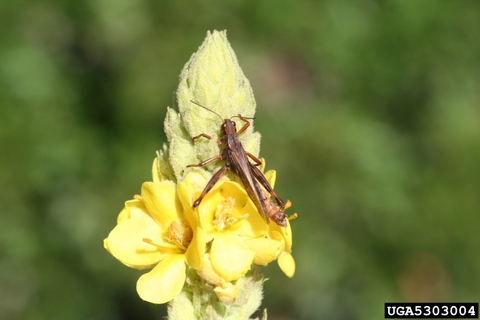Dry weather brings a predictable set of garden challenges, some of which are obvious (watering) while others are more subtle. Insects are greatly affected by temperatures and rainfall, and the largest, most obvious insects we see during periods of dry, hot weather are grasshoppers.
Last summer’s drought likely means we had a large grasshopper population going into this year, and the dry weather some parts of Minnesota are experiencing means that the population continues to grow.
There are a few species of grasshoppers in Minnesota, though they all have similar biology. There is one generation a year, and small grasshoppers look like miniature versions of adults. Regardless of age or size, grasshoppers feed on leaves, creating unsightly holes.
Where are grasshoppers feeding?
Gardeners often want grasshoppers gone – they are big, obvious bugs. When thinking about if it is worth it to do something about grasshoppers, think about how much feeding you are seeing and where you are seeing the feeding.
For example, in many of the community gardens I’ve been in this summer, grasshoppers are a common sight, but not on crops. Instead, the feeding has been limited to pollinator plantings or weedy areas at the edge of the garden. In these cases, grasshoppers are around but limited to areas we aren’t harvesting, so this is a scenario where you can live and let live.
Populations change with rainy weather
It is also important to think about how grasshopper populations could change with the weather. The reason we don’t have large grasshopper populations during rainy years is that the wet weather promotes the development and spread of a grasshopper-killing fungus. This fungus infects grasshoppers, hijacking their bodies. If you see an unmoving grasshopper hanging out high up on a plant, you are likely seeing a grasshopper that has been attacked by the fungus. The fungus makes the grasshopper climb to a high point and die, which allows the fungus to better spread its spores. Many parts of south-central Minnesota recently received a few inches of rain, which could allow the fungus to take a bite out of grasshopper populations.
Grasshoppers are often not worth treating. This is because the damage they do often isn’t significant. Plants can tolerate feeding, so it isn’t worth treating over a few holey leaves.
Grasshoppers are also large and highly mobile, making it hard to use pesticides on them. Attempts to treat grasshoppers in gardens are often unsuccessful, and the pesticides can have unintended effects on pollinators and other good bugs.
If you have had major grasshopper damage in the past, there are organic-approved baits available. These baits contain a microbe that kills grasshoppers and is most effective when grasshoppers are small. So if you are seeing many small grasshoppers in areas with a history of issues, get the baits out as soon as possible.



